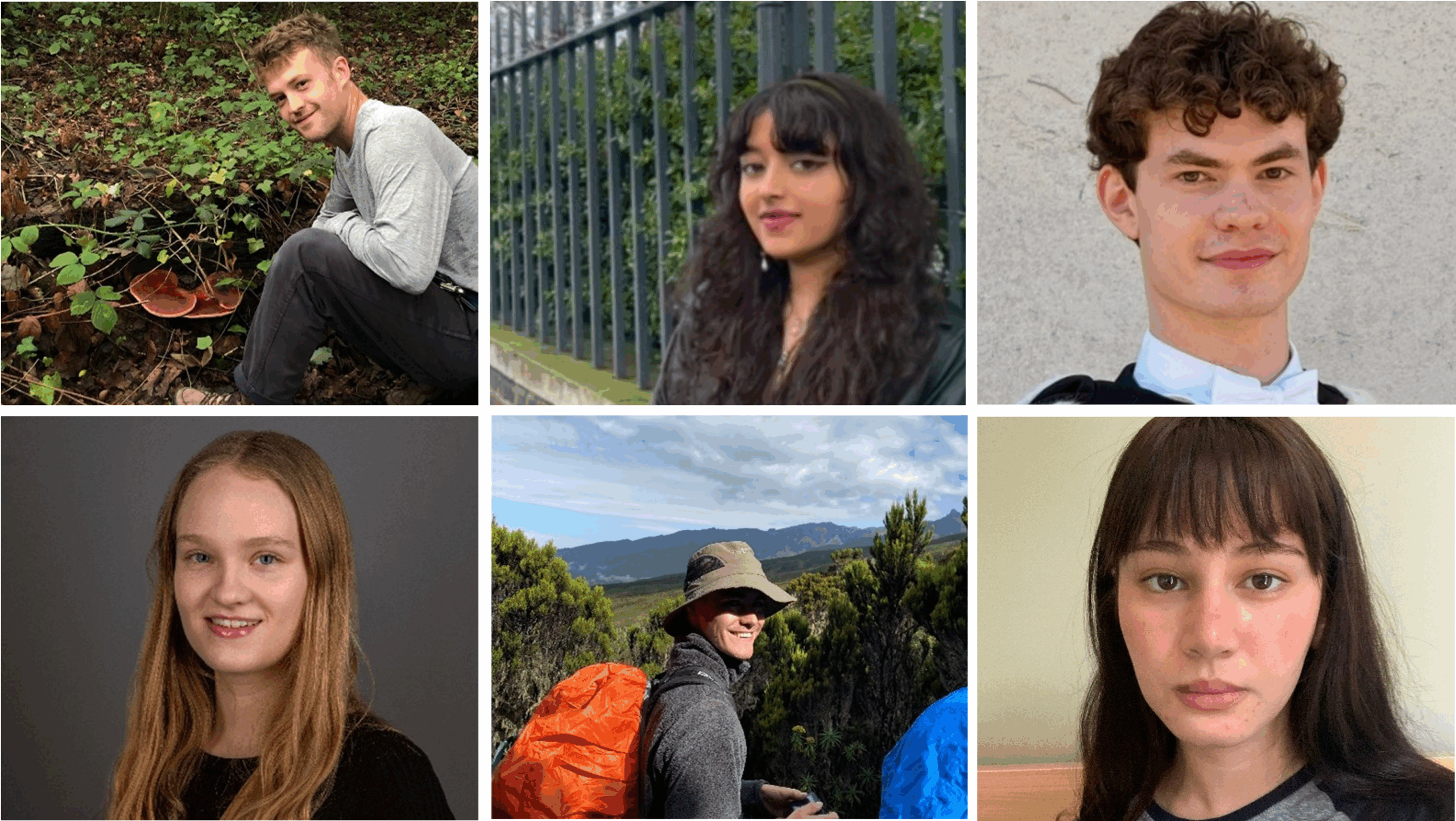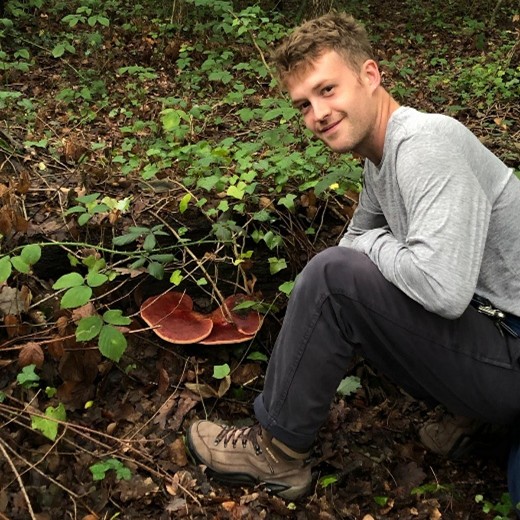Meet our 2025/26 Interns!
Find out more about each of our current interns and the projects they are working on 👇


Flynn – The development of non-destructive testing methodologies to assess shake in standing oak trees
Hi, my name is Flynn, and I’ve just started an internship with the CFP working on the development of non-destructive testing methodologies to assess shake in standing oak trees. I’ll be based out of the Northern Research Station near Edinburgh for the most part, but our project study site is based down in the Wyre Forest in Shropshire, where I’ll be spending the next few weeks gathering data. Our fieldwork will involve using acoustic sensors to detect shakes and irregularities in oak stems and assessing the nature and extent of the shake in each tree.
I have just finished studying an MSc in Environmental Forestry at Bangor University, but prior to this I had worked developing mycelium materials, as well as jobs in arboriculture, forestry, and fabrication. My undergraduate degree was in anthropology, so I have a wide-ranging set of research interests!
This project appealed to me as I have an enduring fascination with regenerative materials and material culture. The timescales involved in growing quality oak timber are huge, so detailed care must be taken to establish resilient trees which will provide a valuable natural resource for future generations. Hopefully our work can help forest managers and tree breeders with a strong evidence base with which to make impactful decisions.
After the internship finishes in Spring, I’m hoping to continue working either in research or landscape-scale ecological restoration and management. I believe this opportunity will equip me with valuable scientific skills and insight to bring with me wherever I go next.
Read more about the Detecting and Understanding Oak Shake – Centre for Forest Protection project.
Vedika – Combining dendrochronology and genomics to understand genomic resilience in English oak
I finished off my Integrated Master’s in Computational Biology at UCL earlier this year, where I developed an interest in using quantitative methods to answer ecological and conservation questions. In my final year, I worked in the People and Nature Lab with Dr Daniel Maynard on a project exploring what drives functional resilience in trees, building a large-scale model that brought together climatic and environmental variables, forest inventory records, and vegetation indices derived from satellite data. That experience, alongside earlier work in phylogenetics with Prof Ziheng Yang comparing different phylogenomic models using large genomic datasets, really cemented my enthusiasm for data-intensive research that can inform how we manage and protect ecosystems.
I am working with Dr James Borrell and Dr Anna Bazzicalupo and collaborators at Forest Research UK on a project that combines dendrochronology and genomics to understand genomic resilience in English oak. The Forest Research UK team collected cores and leaf samples from provenances across the UK earlier this year, and my role focuses on developing and optimising DNA extraction protocols for both leaf material and core samples before downstream sequencing. Once the sequencing is complete, the aim is to integrate the genomic data with dendrochronological analyses and historic and projected climate data to assess how well different oak populations are equipped to cope with future environmental change.
This internship appealed to me because it gave me the opportunity to apply skills I gained during my degree such as ecological modelling, genomics, and nucleic acid extraction. It felt like an ideal opportunity to apply those skills in a setting where the findings can directly inform conservation and forest management decisions, whilst also learning new techniques and working with a lovely team. Working at Kew comes with the added benefit of getting to explore the gardens whilst I’m waiting for my samples to centrifuge!
Looking ahead, I am keen to stay in this space and build more experience across the sector, whether that is through further time in the lab, field-based projects, or roles closer to policy and implementation. Longer term, the plan is to start a PhD focused on questions at the interface of genomics, ecology, and conservation.
Read more about the Applying dendrochronology for genomic resilience – Centre for Forest Protection project.


Finlay – Investigating the resilience of Scots pine to drought and waterlogging
As a CFP intern, I am based in Scotland at Forest Research investigating the resilience of Scots pine to drought and waterlogging – abiotic extremes that may become more frequent as our climate continues to change. My project focuses on exploring data collected across a 14-week glasshouse trial to determine how pine seedlings responded physiologically to different treatments, and the factors that influence this response.
I started this internship after completing my undergraduate degree, where I specialised in Plant Sciences in my final year. This gave me a breadth of knowledge, from photosynthetic pathways to ecological networks, that I hope could lead to opportunities across the field, or in conservation more generally.
Although I am still unsure what my career path will look like, but I am currently considering undertaking a Master’s degree next year. I hope my internship will be an important step along this path, offering valuable insights into tree research and forestry while strengthening my abilities in data handling and statistical analysis.
Read more about the Investigating Scots pine resilience – Centre for Forest Protection project.
Jessica – Supporting the re-establishment of the Scots pine breeding programme
Hi, I’m Jessica, and I started this internship in October after finishing my studies.
I have a BSc in Biological Sciences and have recently completed the work for an MSc in Bioinformatics. I have been curious about forestry for a while so I’m very grateful for this opportunity to gain initial experience and learn as I work.
The role of my internship is to support the re-establishment of the Scots pine breeding programme and to re-analyse old trials with modern statistical methods. It is part of the Centre for Forest Protection project “Infusing resilience into the Scots pine genetic resource.” I was keen to apply to put my skills (such as coding and data analysis) into practice and to gain work experience in an environmentally impactful sector. Additionally, I like that I have a variety of activities to go alongside the desk-based work such as visiting forest trials and conducting seed extractions.
I am learning more about career paths in forestry and research and I am excited to explore roles after the internship where I can build on my experience.
Read more about the Infusing resilience into the Scots pine genetic resource – Centre for Forest Protection project.


Liam – Simulating potential increases in ash dieback
I have recently completed a master’s in quantitative genetics at The University of Edinburgh where I learned a lot about animal and plant breeding genetics.
I am working on the Ash dieback resistance project at Kew. I am currently making simulations to reflect potential Ash tree breeding programmes. Our goal is to evaluate the efficiency of a potential Ash tree breeding programme using the information we have about the genetics of resistance to the disease.
I’m really motivated by using genetics knowledge in conservation and improving efficiency in breed programmes. As a result, I looked for an opportunity where I could apply my knowledge and skills.
I am hoping to continue working in applying genetics knowledge to breeding and am hoping to either further study in that area or work within industry.
Read more about the Investigating ash health genomics after long-term ash dieback exposure – Centre for Forest Protection project.
Cas – Simulating potential increases in ash dieback
I graduated last year with an MBiol from Durham University. At the beginning of my undergraduate degree, I was studying a mixture of mathematics, chemistry, and biology. Though I had never heard of bioinformatics before university, I found myself gravitating towards it, and I eventually narrowed down my focus to computational biology in my final year.
After graduating, I joined the Plant Health and Adaptation group at Kew to do some genomics work on elm trees – I ended up enjoying it so much that I returned for a second research project, and I am now using the skills I developed to study ash trees, doing a mixture of genomics and evolutionary modelling.
I’m applying to PhD programmes this autumn, and hope to continue working in the field of computational biology.
Read more about the Investigating ash health genomics after long-term ash dieback exposure – Centre for Forest Protection project.

Science & Research
Our science programme will support the UK governments' forest and tree strategies and the successful delivery of tree planting programmes. Research outcomes will also directly contribute to the improved resilience of the UK’s forests, woodlands and trees and help promote enhanced capacity and capability in forest and tree health research.

Our Partners
Social media
Explore
Contact
© 2022 Centre for Forest Protection. All rights reserved.